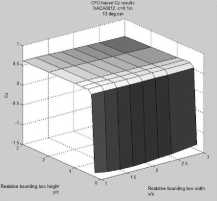9574065318
12 Krzysztof Olasek, Maciej Karczewski


Fig. 2 Surface plots - lift coefficient results, a) fora=5°, b) fora=13°
Visible is the asymptotic character of obtained surfaces forthe integral linę sizes, for a=5° values of cz approach the reference value for x/c slightly bigger than 1 and y/c«1). Similar behaviour, and morę easily identifiable, is seen for a=13°, where beyond y/c=0.5, cz abruptly decreases for the entire rangę of x/c values. A conclusion can be madę that rectangle size (or integration linę length) should be chosen in such a way as to encompass the investigated airfoil as closely as possible. Therefore, the same width/chord (x/c) ratio, equal to 1.25, can be used for a wide rangę of angles of attack. Likewise, the height/chord ratio tends to a minimum, remembering that y/c dimension must increase as the airfoil angle of attack increases.
Another important factor is the size of the flow structures induced by the airfoil's inclination. For higher angles of attack (beyond the static stall) a separation region appears above the airfoil's top surface. As mentioned, it can be noticed that for a=13° and y/c ratio<0.5, a sudden drop of lift coefficient occurs. Thus, another recommendation forthe choice of the integral curve size, should be to the inclusion of separation region inside the integral rectangle. Otherwise, velocity data used for the circulation function gives unreliable lift results. Fig. 3 demonstrates the changes of the integration window size for 3 cases.
Wyszukiwarka
Podobne podstrony:
14 Krzysztof Olasek, Maciej Karczewski 6. RESULTS In order to verify the proposed algorithm for lift
Krzysztof Olasek, Maciej Karczewski a modernised wind tunnel test stand adapted for the aerodynamic
10 Krzysztof Olasek, Maciej Karczewski 4. MATLAB SCRIPT Post-processing of CFD data was possible tha
osiągnięcia pracowników i studentów wydziału informatyki zut w szczecinie Krzysztof Grączewski, Maci
12 KRZYSZTOF DOROSZ otchłań czyni Boga Bogiem: jest istotą Jego majestatu, niedostępną intensywności
11. Maciej Karczewski (Białystok) - Czasy potopu szwedzkiego na Mazurach. Kilka uw
Robert Mazur, Andrzej Lewicki, Krzysztof Przybył, Maciej Zaborowicz, Krzysztof Koszela, Piotr Boniec
42 (158) Szkoła Konstruktorów Fot. 16 Michał Stec Fot. 12 Krzysztof Kruszka Fot. 17 i 18 Model Micha
12 Krzysztof Górecki, Zastosowanie programu SPICE do modelowania ... uzyskania zależności prądu kole
12 Krzysztof Górecki, Zastosowanie programu SPICE do modelowania ... uzyskania zależności prądu kole
12 Krzysztof Dziadek finansową i dokonania jednostki1 oraz tworzyć warianty rozwiązywania problemów
No. 142 CIEPLNE MASZYNY PRZEPŁYWOWE TURBOMACHINERY 2012 Krzysztof OLASEK Institute of
Maciej Karczewski Uniwersytet im. A. Mickiewicza w PoznaniuSport w stosunkach międzynarodowych. Wstę
Maciej Karczewski cu 1969 r., w ramach eliminacji do Mistrzostw Świata w Piłce Nożnej w Meksyku. Prz
więcej podobnych podstron